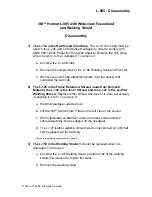
2
Sensor Operation
The MOS-21 sensor monitors motion in interior spaces. The sensor is powered
by solar energy from natural or artificial light sources. The solar energy is
transformed into electrical energy which is then stored providing a continuous
power source for the sensor. Powered by six solar cells, the sensor can operate
without battery backup for up to 225 hours. The sensor will operate even with a
brief exposure to light, however for best results the sensor should be mounted
in a location with exposure for 2 hours of natural or artificial light (160 - 500 lux
or 16-50 fc) on a daily basis.
A battery (CR2032) must be installed in the MOS-21
x
C sensor for use in high
bay applications.
The motion sensor supports the Occupancy Sensor EnOcean profile A5-07-01.
The sensor will transmit occupancy or vacancy depending on the occupancy
state of the room. The sensor will broadcast occupancy immediately upon a
state change from vacant to occupied. The sensor broadcasts a telegram when
movement is detected and repeats occupied telegrams with a minimum 100
second period between subsequent transmissions.
After detecting motion, the sensor is shut-down to conserve energy for
100 seconds. When the sensor awakens and no motion is detected, the
sensor transmits a vacancy telegram after 100 seconds, 200 seconds total
since the previous transmission. The sensor will remain active until the next
occupancy state. If the sensor does not detect motion, it resends the vacancy
telegram every 1000 seconds.
The sensor must be within range of any linked receivers or controllers, installed
within 24m (80’) of each other. For applications exceeding 24m (80’) range,
telegram repeaters may be needed to extend reception range.
Motion Detection
The MOS family uses a PIR sensor that detects motion by measuring the infrared
energy given off by objects. The sensor is calibrated to detect the heat range of
human body temperature. The sensor has a lens that breaks the viewing angle
of the sensor into zones (movement zones). It is the movement of the infrared
energy moving in and out of a zone that defines occupancy. The amount of
movement that triggers the sensor is dependent upon the density of the zones
where the motion takes place. A higher density of zones means smaller motion
will trigger the sensor.
For detection of small motion (typing, drinking from a coffee cup), use the MOS-
21A model which has a lens with more movement zones. Place the sensor close
to the location where the motion may occur.
A red LED under the lens will blink once every 100 seconds when the sensor
detects motion.


























